Bathroom Enhancements
Bathroom Sizes: From Tiny Powder Rooms to Spacious Full Baths

Have you ever wondered about the size of bathrooms and how they can range from tiny powder rooms to spacious full baths?
Well, in this article, we will dive into the world of bathroom sizes and explore the various dimensions you can find.
From small bathrooms in homes under 2,000 square feet to luxurious full baths in larger homes, we’ll cover it all.
So, get ready to discover the ideal dimensions for your bathroom and learn some tips on maximizing space.
Key Takeaways
- The size of a bathroom can vary based on the size of the home, with small bathrooms in homes under 2,000 square feet typically having 93 square feet of dedicated space.
- Powder rooms, which typically only have a sink and a toilet, can range from 18 to 32 square feet in size, with older homes sometimes having bathrooms as small as 11 square feet.
- Small three-quarter bathrooms, which include a toilet, sink or vanity, and a shower, can have layouts of 6-by-6 feet or 5-by-7 feet, providing about 35 to 36 square feet of space.
- Small full bathrooms, which can include a toilet, sink, shower, and bathtub, typically range from 36 to 40 square feet in size, with a common dimension for a guest bathroom being 5-by-8 feet.
Average Bathroom Sizes in Homes Under 2,000 Square Feet
If you live in a home under 2,000 square feet, your bathroom will typically have 93 square feet of dedicated space, excluding the master bathroom. In homes with limited square footage, maximizing space in small bathrooms with creative layouts is essential.
While the average size of these bathrooms may be smaller, there are various ways to make the most of the available space. Consider incorporating space-saving fixtures like corner sinks or compact toilets. Opt for smaller showers or shower-tub combos to ensure there is enough room for other bathroom essentials.
Utilize vertical storage with shelving or wall-mounted cabinets to keep the floor clear. Mirrors can also help create the illusion of a larger space. By carefully planning and utilizing innovative design strategies, you can maximize the functionality and aesthetics of your small bathroom.
Average Bathroom Sizes in Homes About 3,000 Square Feet
When considering a home about 3,000 square feet, you can expect to have a dedicated bathroom space of approximately 146 square feet. This size allows for more flexibility in designing your bathroom to meet your needs and preferences.
However, for homes under 1,000 square feet, average bathroom sizes tend to be smaller. Designing a small bathroom requires careful consideration to maximize space.
Some design tips for maximizing space in small bathrooms include using compact fixtures, such as a pedestal sink or a corner shower, to save space. Utilizing vertical storage, such as wall-mounted cabinets or shelves, can also help to maximize space. Additionally, using light colors and mirrors can create the illusion of a larger space.
Tiny Half Bathrooms: Layouts and Sizes
To maximize space in your small half bathroom, consider attaching a faucet-to-shower converter to the sink for added versatility.
Tiny half bathrooms can have layouts ranging from 18 to 32 square feet, with some older homes even having bathrooms as small as 11 square feet. These powder rooms typically only have a sink and a toilet, making them a convenient option for guests.
By adding a faucet-to-shower converter, you can transform your tiny half bathroom into a more functional space. This allows you to have the option of a shower, making it easier to accommodate guests or even use it as a secondary bathroom for yourself.
Optimizing space in small bathrooms is crucial, and this simple addition can make a significant difference in your tiny half bathroom layout.
Older Homes: Small Bathrooms of 11 Square Feet
Consider utilizing creative storage solutions and maximizing vertical space in your small 11 square foot bathroom to make the most of the limited area. When renovating small bathrooms, it’s important to think outside the box and find unique ways to store your essentials.
One option is to install floating shelves above the toilet or sink, providing additional storage without taking up valuable floor space. Another creative solution is to use vertical wall-mounted cabinets or baskets to keep toiletries organized and easily accessible.
Utilizing the space above the door with a shelf or a hanging organizer can also free up valuable space. Additionally, consider using stackable storage containers or bins under the sink to maximize your storage potential.
With a little creativity and some smart planning, you can transform your small bathroom into a functional and stylish space.
Powder Rooms: Sink and Toilet Only
You can maximize the limited space in a sink and toilet only powder room by using clever storage solutions and keeping the area organized. Designing a functional and stylish powder room can be a challenge, but with the right strategies, you can create a space that feels spacious and inviting.
Here are some design tips for maximizing space in powder rooms:
-
Utilize vertical storage: Install shelves or cabinets above the toilet or sink to take advantage of the vertical space. This will provide additional storage for toiletries, towels, and other bathroom essentials.
-
Opt for wall-mounted fixtures: Choose wall-mounted sinks and toilets to free up floor space. This will create a more open and airy feel in the powder room.
-
Use creative storage solutions: Consider using baskets, bins, or wall-mounted organizers to keep small items organized and easily accessible. You can also use hooks or towel bars on the back of the door or wall to hang towels or robes.
Adding a Shower Option to a Powder Room
Adding a shower option to a powder room can create a more versatile and functional space. When designing small bathrooms with separate showers and bathtubs, maximizing space is crucial.
Here are some design tips to help you make the most of your powder room.
First, consider using a faucet-to-shower converter attached to the sink. This allows you to easily add a shower option without taking up extra space.
Another tip is to use sliding doors for the shower instead of hinged swinging doors. Sliding doors save space and make the room feel less cramped.
Additionally, choose compact fixtures and fittings to maximize the available space.
Finally, consider incorporating built-in storage solutions to keep the room organized and clutter-free.
Small Three-Quarter Bathrooms: Layouts and Design Tips
To maximize the space in a small three-quarter bathroom, try tucking the shower stall or vanity in one corner. This can make the bathroom seem more open and less cramped.
In addition to this design tip, here are three more tips to help you maximize storage and create a stylish look in your small three-quarter bathroom:
-
Utilize vertical space: Install shelves or cabinets above the toilet or vanity to take advantage of vertical space for storage. This will free up valuable floor space and keep your bathroom essentials organized.
-
Opt for creative color schemes: Choose light, neutral colors for the walls and flooring to create an illusion of a larger space. Consider using a pop of color in accessories or accents to add visual interest without overwhelming the small bathroom.
-
Use multipurpose furniture: Look for furniture pieces that can serve multiple functions, such as a vanity with built-in storage or a mirrored medicine cabinet that also acts as a mirror. This will help you maximize storage while keeping the bathroom clutter-free.
Small Full Bathrooms: Layouts and Fixtures
Consider the layout and fixtures that will best suit your small full bathroom. When designing a small full bathroom, it’s important to maximize space and create a functional yet stylish environment. Storage solutions are essential in small bathrooms to keep everything organized and clutter-free. Utilize wall-mounted shelves, under-sink cabinets, and over-the-toilet storage units to make the most of vertical space.
Lighting options play a crucial role in enhancing the overall ambiance of a small full bathroom. Incorporate a combination of task lighting, such as vanity lights, and ambient lighting, such as recessed lights or a pendant light, to create a well-lit and inviting space. Consider using mirrors strategically to reflect light and create an illusion of a larger bathroom.
With the right layout and fixtures, your small full bathroom can be both functional and aesthetically pleasing.
Small Full Bathrooms With Separate Shower and Bathtub: Ideal Sizes
Maximize space and create a functional yet stylish environment in your small full bathroom with separate shower and bathtub by strategically utilizing storage solutions and incorporating the right lighting options. Here are some design tips for small bathrooms with separate shower and bathtub:
-
Opt for built-in storage: Install shelves or cabinets above the toilet or vanity to maximize vertical space. Consider using wall-mounted storage solutions to keep the floor clear and create a sense of openness.
-
Use light colors: Light-colored walls and tiles can make the bathroom appear larger and brighter. Avoid dark colors that can make the space feel cramped.
-
Install recessed lighting: Recessed lighting fixtures can provide ample light without taking up precious space. Consider adding a dimmer switch to create a relaxing ambiance when needed.
Maximizing Space in Small Bathrooms With Sliding Shower Doors
Choose a sliding shower door to save space and create a more open feel in your small bathroom.
Maximizing storage in small bathrooms is essential, and using space-saving fixtures can make a significant difference. Sliding shower doors are a practical solution that allows you to optimize the available space.
Unlike hinged swinging doors, which require extra room to open, sliding doors simply glide along a track. This design eliminates the need for clearance space, making it ideal for small bathrooms.
Frequently Asked Questions
What Are Some Design Tips for Maximizing Space in Small Bathrooms With Sliding Shower Doors?
Maximize space in your small bathroom with sliding shower doors. They save space compared to hinged doors, allowing for more room to move. Consider creative storage solutions to keep your bathroom organized and clutter-free.
Are There Any Recommended Dimensions for a Small Full Bathroom With a Separate Shower and Bathtub?
Recommended dimensions for a small full bathroom with a separate shower and bathtub are about 45 square feet, with dimensions of 5-by-9 feet. Having a separate shower and bathtub in a small bathroom prevents it from feeling cramped.
What Are the Typical Dimensions for a Small Full Bathroom?
Typical dimensions for a small full bathroom range from 36 to 40 square feet. Consider incorporating a toilet, sink, shower, and bathtub. To avoid a cramped appearance, prioritize separate shower and bathtub options and use sliding doors for showers.
Can You Provide Some Examples of Layouts for Tiny Half Bathrooms?
Layout ideas for tiny half bathrooms include maximizing space by using compact fixtures, such as a small sink and toilet. Creative storage solutions, like wall-mounted shelves or recessed cabinets, can help keep the space organized and functional.
How Can I Add a Shower Option to a Powder Room?
To add a shower option to your powder room, consider attaching a faucet-to-shower converter to the sink. This can provide the functionality you desire while saving space and avoiding the cost of installing a separate shower in a small bathroom.
Conclusion
In conclusion, bathroom sizes can vary greatly depending on the needs and preferences of homeowners. From tiny powder rooms to spacious full baths, there is a wide range of options available.
One interesting statistic to consider is that small bathrooms in older homes can be as small as 11 square feet. This highlights the challenges of maximizing space in older homes, and the importance of thoughtful design and fixtures.
Regardless of size, it is crucial to make the most of the available space and consider options like sliding shower doors to prevent the bathroom from feeling cramped.
With an impeccable eye for detail and a passion for bathroom-related, Ava leads our editorial team gracefully and precisely.
Under her guidance, Best Modern Toilet has flourished as the go-to resource for modern bathroom enthusiasts. In her free time, you might find Ava exploring antique shops and looking for vintage bathroom fixtures to add to her collection.
Bathroom Enhancements
What Size Bathroom

We’ve all heard the phrase, ‘size doesn’t matter,’ but in the case of bathrooms, it does. Selecting the appropriate size for your bathroom can greatly impact how functional and comfortable the space is.
In this article, we’ll guide you through the process of assessing your needs and constraints, analyzing the available space, and choosing the right fixtures and fittings.
Get ready to optimize your bathroom and make it a place of relaxation and functionality.
Key Takeaways
- Assess the size and layout of the available space.
- Determine specific requirements, such as the number of users and activities.
- Analyze existing plumbing and structural constraints.
- Ensure the bathroom design meets requirements and budget.
Assessing Your Needs and Constraints
When assessing our needs and constraints for a bathroom, it’s important to consider the size and layout of our space.

Design considerations and budget planning play a crucial role in determining the right size for our bathroom. Firstly, we need to think about our specific requirements, such as the number of people using the bathroom and the activities that will take place in it. This will help us determine the necessary fixtures and storage space.
Additionally, we must consider the layout of our space, taking into account any existing plumbing or structural constraints. By carefully analyzing our needs and constraints, we can ensure that our bathroom design meets our requirements while staying within our budget.
Now, let’s move on to the next section and analyze the available space in more detail.
Analyzing the Available Space
Now, let’s assess the available space in order to determine the ideal size for our bathroom. To make the most of the space, we should consider the following:

- Maximizing natural light: By incorporating large windows or skylights, we can fill the bathroom with natural light, creating a bright and airy atmosphere.
- Incorporating a spa-like atmosphere: To achieve a spa-like feel, we can allocate space for a luxurious bathtub or a spacious walk-in shower. Adding features like a rain showerhead or a heated towel rack can enhance the relaxing ambiance.
- Optimizing storage: Utilizing wall-mounted cabinets, shelves, or recessed niches can help maximize storage space without sacrificing floor area.
- Efficient layout: Planning a well-thought-out layout that ensures easy movement and accessibility is crucial. Consider the placement of fixtures, such as the toilet, sink, and shower, to optimize functionality.
- Choosing appropriate fixtures: Selecting fixtures that are scaled appropriately to the available space helps maintain a balanced and harmonious design.
Determining the Functional Layout
To determine the functional layout of our bathroom, we’ll assess the available space and consider factors such as movement, accessibility, and fixture placement. Maximizing comfort and considering accessibility are key elements in creating a bathroom that meets our needs.
We’ll ensure that there’s enough space for easy movement and that the layout is user-friendly for individuals with different mobility levels. Additionally, we’ll strategically place fixtures such as the sink, toilet, and shower/tub to optimize functionality and convenience.
By carefully considering these factors, we can create a bathroom layout that promotes comfort and accessibility.
In the next section, we’ll discuss the importance of choosing the right fixtures and fittings to complement the functional layout of our bathroom.
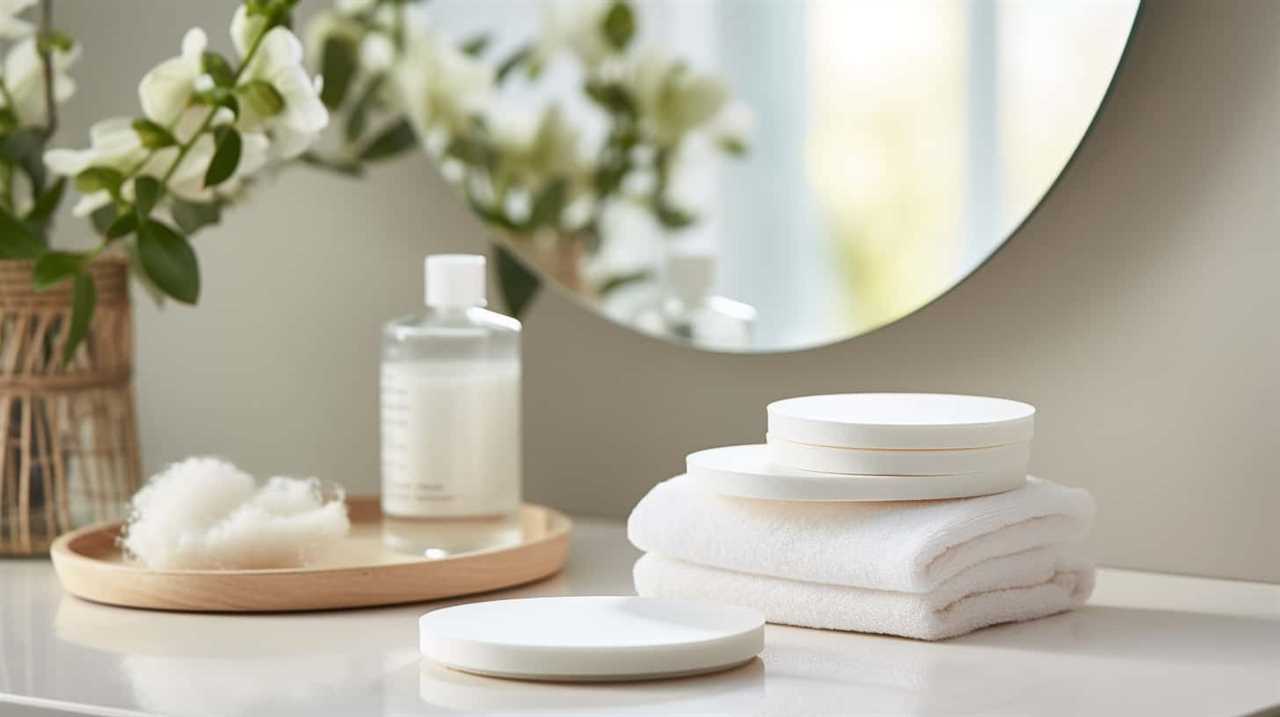
Choosing the Right Fixtures and Fittings
Now that we’ve determined the functional layout of our bathroom, we’ll focus on selecting the right fixtures and fittings to enhance its design and functionality.
When choosing the right materials for our bathroom fixtures and fittings, it’s important to consider their durability and resistance to moisture. Opting for materials such as porcelain or ceramic for sinks, toilets, and bathtubs can ensure longevity and easy maintenance.
Additionally, we should prioritize maximizing energy efficiency by selecting fixtures and fittings that are water-saving and energy-saving. Look for faucets with low-flow features and toilets with dual-flush systems. Installing LED lighting fixtures can also contribute to energy efficiency.
Optimizing Storage Solutions
When considering optimizing storage solutions in our bathroom, it’s important to continue the discussion on selecting the right fixtures and fittings to enhance the design and functionality of the space.

Maximizing space is crucial in small bathrooms, and creative organization is key to achieving this. One effective way to maximize space is by utilizing vertical storage solutions, such as installing shelves or cabinets above the toilet or next to the vanity.
Another option is to make use of the back of the bathroom door by adding hooks or a hanging organizer for towels and toiletries.
Additionally, incorporating built-in storage, such as recessed shelving in the shower or a medicine cabinet, can help keep the bathroom clutter-free.
Frequently Asked Questions
How Much Does a Bathroom Renovation Typically Cost?
The average cost of a bathroom renovation can vary depending on several factors. These factors include the scope of the renovation, the materials used, and any additional features or upgrades.
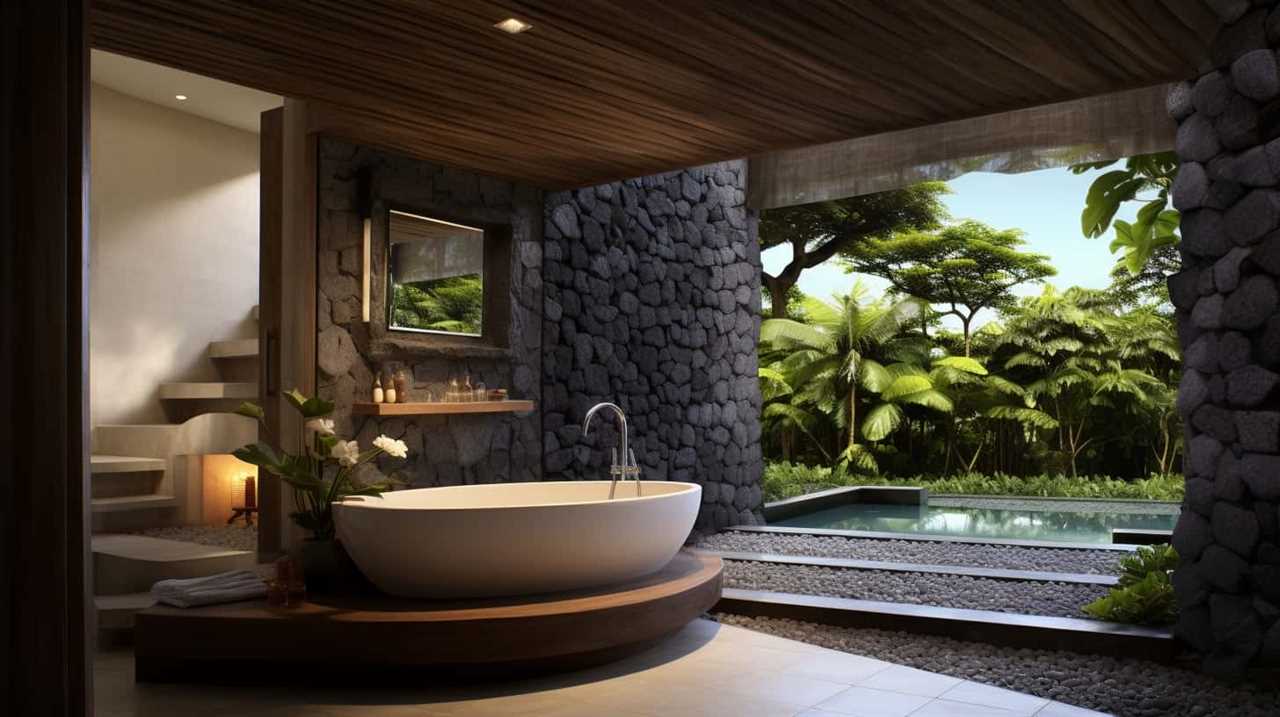
What Are Some Common Mistakes to Avoid When Designing a Bathroom?
Common mistakes to avoid when designing a bathroom include neglecting important considerations like proper lighting, insufficient storage, and poor ventilation. It’s crucial to plan carefully and avoid these pitfalls for a successful bathroom design.
Are There Any Specific Building Codes or Regulations to Consider When Remodeling a Bathroom?
When remodeling a bathroom, it’s important to consider building code requirements. These regulations ensure the safety and functionality of the space. Additionally, avoiding common mistakes in bathroom remodeling can help achieve a successful renovation.
What Are Some Popular Bathroom Design Trends to Consider?
When considering bathroom design trends, we should focus on aspects like bathroom lighting and minimalist designs. These trends emphasize a clean and sleek aesthetic, creating a modern and functional space.
How Long Does a Bathroom Renovation Usually Take to Complete?
Bathroom renovation timelines vary depending on the scope of the project. Factors such as the size of the bathroom, complexity of the remodel, and availability of materials can impact the duration.

Conclusion
In conclusion, when designing a bathroom, it’s crucial to assess your needs and constraints. This involves determining what specific requirements you have and what limitations you might face in terms of budget, space, or any other factors.
Next, analyze the available space. Take measurements and evaluate how the bathroom can be best utilized. Consider the placement of doors, windows, and any existing plumbing or electrical connections.
Once you have a clear understanding of the space, determine the functional layout. This involves deciding where to place the shower, toilet, sink, and any other fixtures. Consider factors such as convenience, accessibility, and privacy.
Choosing the right fixtures and fittings is another important aspect of bathroom design. Select items that are not only visually appealing but also durable and practical. Consider factors such as water efficiency, ease of maintenance, and compatibility with the overall design theme.
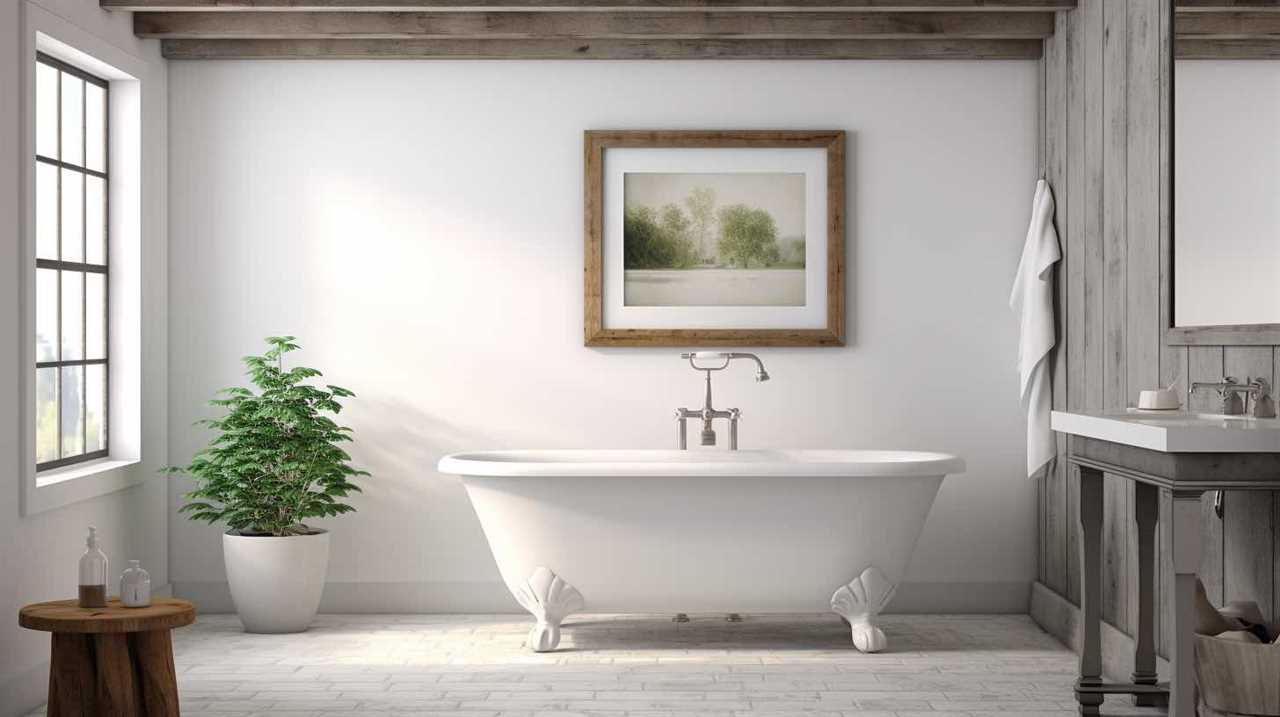
Finally, optimize storage solutions. Bathrooms often require ample storage for toiletries, towels, and other essentials. Look for creative ways to maximize storage space, such as using wall-mounted shelves, built-in cabinets, or freestanding storage units.
By carefully considering these factors, you can create a bathroom that’s both functional and aesthetically pleasing. Remember, size doesn’t limit style and functionality!
With an impeccable eye for detail and a passion for bathroom-related, Ava leads our editorial team gracefully and precisely.
Under her guidance, Best Modern Toilet has flourished as the go-to resource for modern bathroom enthusiasts. In her free time, you might find Ava exploring antique shops and looking for vintage bathroom fixtures to add to her collection.
Bathroom Enhancements
What Is Bathroom Cladding

Are you tired of your dull bathroom walls? Get ready to be impressed! Let us introduce you to the benefits of bathroom cladding.
This revolutionary technique will transform your space in no time. Say goodbye to dull tiles and hello to a modern, stylish look.
In this article, we’ll explore what bathroom cladding is, its benefits, and how to install it. Get ready to master the art of bathroom transformation!
Key Takeaways
- Bathroom cladding is a material used to cover walls or ceilings in bathrooms, enhancing their appearance and durability.
- PVC and acrylic are common types of bathroom cladding materials, but laminate, tile, and wood are also options.
- Benefits of bathroom cladding include enhanced aesthetics, easy maintenance, waterproof and durable properties, cost-effectiveness, and quick installation.
- When choosing bathroom cladding, factors to consider are budget, style preference, maintenance requirements, and ensuring it complements the overall bathroom design.
What Is Bathroom Cladding
We often use bathroom cladding to enhance the appearance and durability of our bathrooms. Bathroom cladding refers to the process of covering the walls or ceilings of a bathroom with a material that’s specifically designed for this purpose.
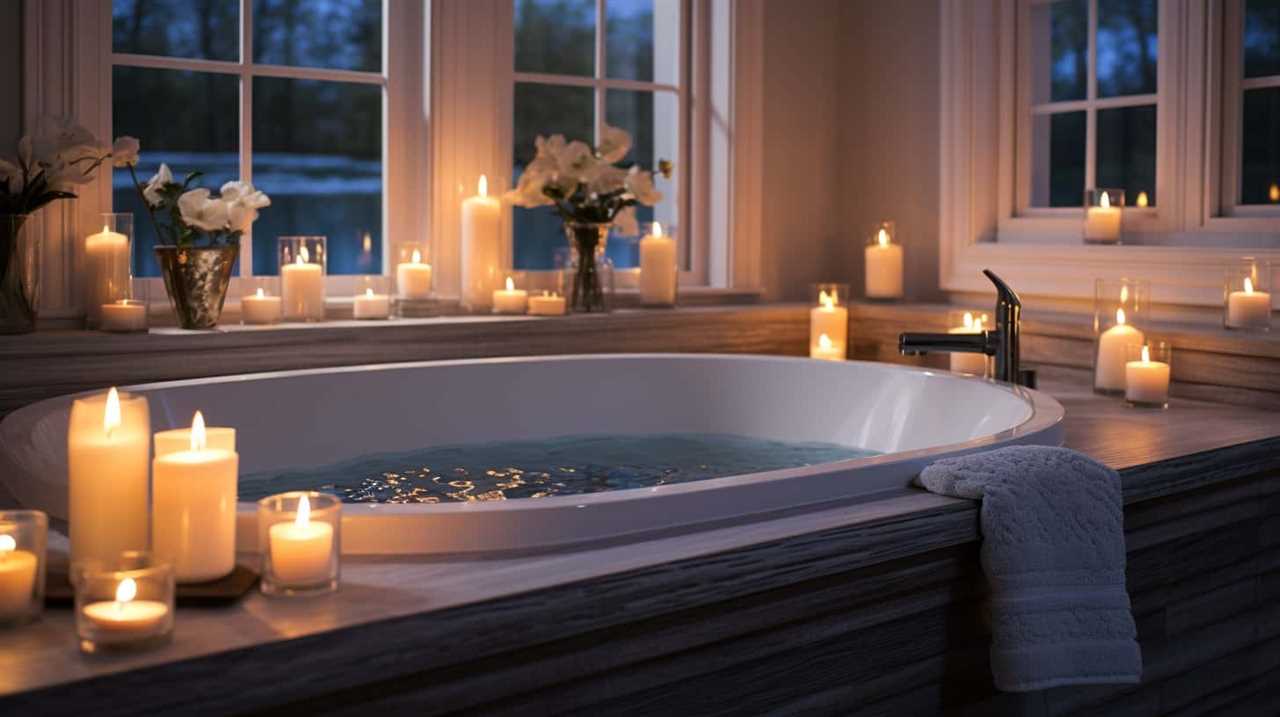
There are various types of materials that can be used for bathroom cladding, each with its own pros and cons. One common type is PVC cladding, which is affordable, easy to install, and low maintenance. Another option is acrylic cladding, which offers a sleek and modern look, but may be more expensive.
Other materials include laminate, tile, and wood cladding. It’s important to consider factors such as budget, style preference, and maintenance requirements when choosing the right cladding material for your bathroom.
The Benefits of Bathroom Cladding
One of the key benefits of bathroom cladding is its ability to provide a number of advantages for homeowners. Here are some advantages of using bathroom cladding:
- Enhanced aesthetics: Bathroom cladding comes in a variety of styles and finishes, allowing homeowners to create a stylish and modern look that suits their taste.
- Easy maintenance: Unlike traditional tiles, bathroom cladding is easy to clean and requires minimal maintenance. It’s resistant to stains, mold, and mildew, making it a practical choice for the bathroom.
- Waterproof and durable: Bathroom cladding is designed to be waterproof, preventing water damage and ensuring longevity. It’s also resistant to scratches and impact, making it a durable option for the bathroom.
- Cost-effective: Bathroom cladding is generally more affordable than tiles, making it a cost-effective choice for homeowners on a budget.
- Quick and easy installation: Bathroom cladding can be installed quickly and easily, saving both time and money compared to traditional tiling methods.
How to Install Bathroom Cladding
Installing bathroom cladding requires careful preparation and precision. To ensure a successful installation, it’s important to avoid common mistakes that can compromise the integrity of the cladding.

One common mistake isn’t properly cleaning the surface before installation. Dust, grease, and dirt can prevent the cladding from adhering properly.
Another mistake isn’t measuring and cutting the panels accurately. This can result in uneven gaps or overlapping panels.
To maintain bathroom cladding, regular cleaning is essential. Use a mild detergent and a soft cloth to wipe down the panels, avoiding abrasive cleaners that can damage the surface.
It’s also important to check for any signs of damage or moisture buildup, as this can indicate a potential problem that needs to be addressed.
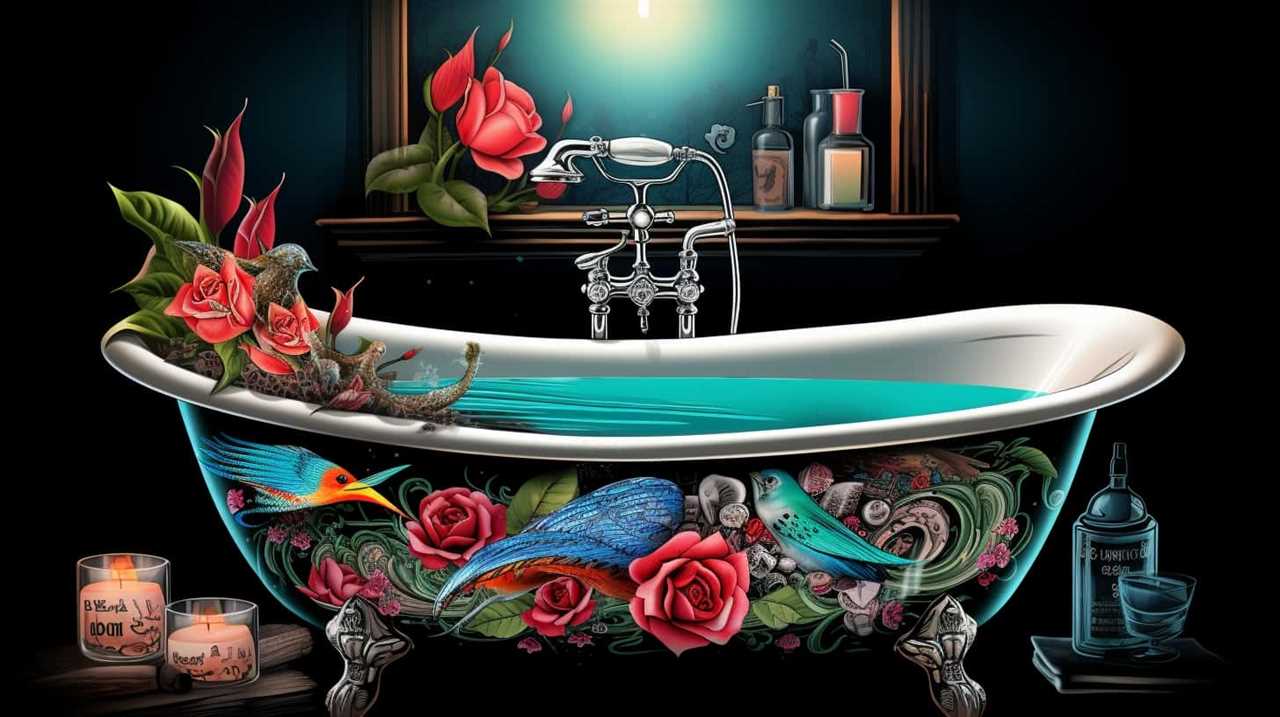
Choosing the Right Bathroom Cladding for Your Space
When selecting bathroom cladding, it’s important to consider factors such as durability, style, and ease of maintenance. To help you make the right choice, here are some common mistakes to avoid and maintenance tips for bathroom cladding:
- Common mistakes when choosing bathroom cladding:
- Neglecting to consider the moisture resistance: Ensure that the cladding you choose is specifically designed to withstand the high humidity and moisture levels typically found in bathrooms.
- Overlooking the style and aesthetic: While durability is important, don’t forget to choose a cladding that complements your overall bathroom design and enhances its visual appeal.
- Maintenance tips for bathroom cladding:
- Regular cleaning: Wipe down the cladding with a mild detergent and water solution to remove any dirt or grime. Avoid abrasive cleaners that can damage the surface.
- Inspect for damage: Check for any signs of wear or damage regularly, and address any issues promptly to prevent further deterioration.
Transforming Your Bathroom With Cladding
To completely transform our bathroom, we can use cladding to create a fresh and modern look.
Bathroom cladding offers a variety of options to suit different styles and preferences. One option is PVC cladding, which is cost-effective and easy to install. It comes in a range of colors, patterns, and finishes, allowing for customization.
Another option is acrylic cladding, which is durable and resistant to moisture, making it perfect for bathrooms. It’s available in various designs and can mimic the look of tiles or natural stone.
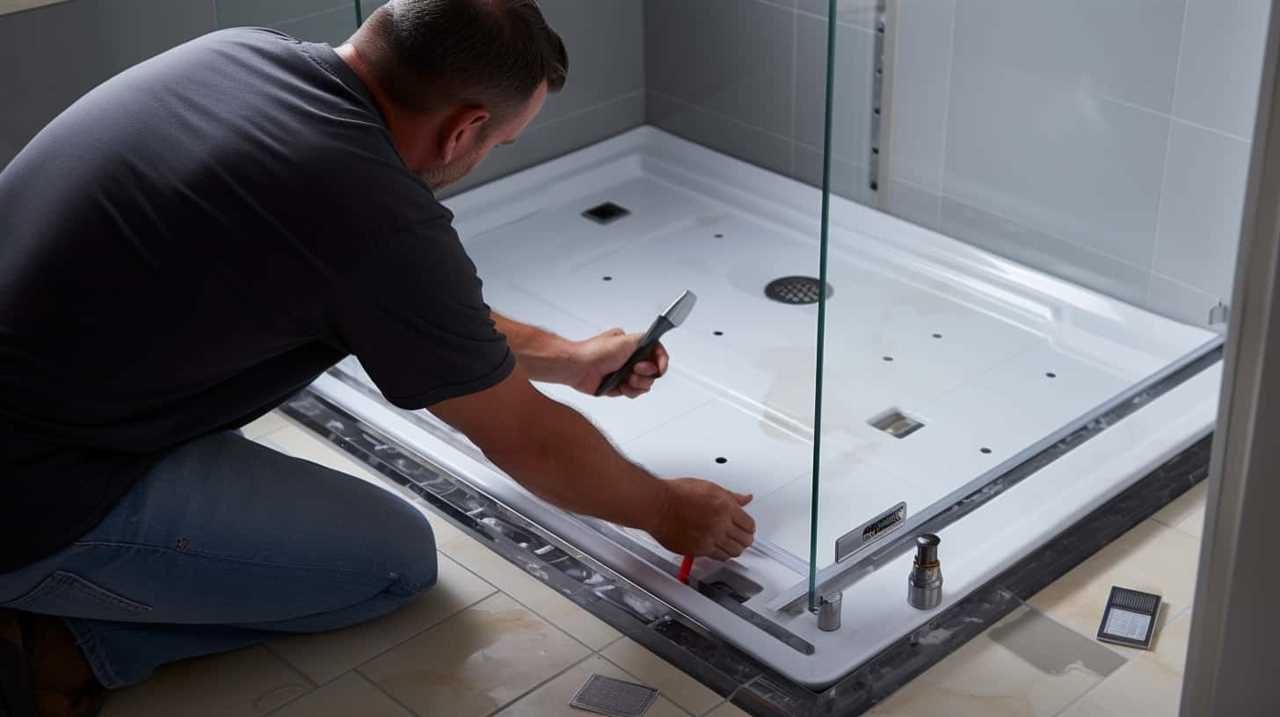
When considering the cost of bathroom cladding, it’s important to factor in the material, installation, and maintenance costs. PVC cladding tends to be more affordable compared to acrylic cladding.
Ultimately, bathroom cladding provides a versatile and cost-effective solution for transforming your bathroom into a stylish and contemporary space.
Frequently Asked Questions
Is Bathroom Cladding Waterproof?
Yes, bathroom cladding is waterproof. It offers several benefits such as protecting the walls from moisture, preventing mold growth, and providing a stylish and easy-to-clean surface for your bathroom.
Can Bathroom Cladding Be Used on All Types of Walls?
Bathroom cladding can be used on most types of walls, but it’s important to ensure a proper installation. The cost of installation varies, and maintenance requirements are generally low, making it a popular choice for many homeowners.

How Long Does Bathroom Cladding Typically Last?
Bathroom cladding typically lasts for a long time due to its durability and low maintenance requirements. It offers an effective solution for walls, enhancing both aesthetics and functionality.
Can Bathroom Cladding Be Easily Removed if Needed?
Yes, bathroom cladding can be easily removed if needed. There are various removal techniques available, such as using a heat gun or adhesive remover. However, it’s important to consider the advantages and drawbacks of removable bathroom cladding before making a decision.
Is Bathroom Cladding a Cost-Effective Alternative to Traditional Tiling?
Yes, bathroom cladding is a cost-effective alternative to traditional tiling. The installation process of bathroom cladding is straightforward, and it requires minimal maintenance. Here are some maintenance tips for bathroom cladding.
Conclusion
In conclusion, bathroom cladding is like a stylish suit of armor for your walls, protecting them from moisture and adding a touch of elegance to your space.

With its easy installation and a wide range of options to choose from, cladding can transform your bathroom into a sanctuary of relaxation and style.
So why settle for plain walls when you can dress them up with the beauty and practicality of bathroom cladding?
Upgrade your bathroom today and indulge in the luxury it deserves.
With an impeccable eye for detail and a passion for bathroom-related, Ava leads our editorial team gracefully and precisely.
Under her guidance, Best Modern Toilet has flourished as the go-to resource for modern bathroom enthusiasts. In her free time, you might find Ava exploring antique shops and looking for vintage bathroom fixtures to add to her collection.
Bathroom Enhancements
What Bathroom Stall

We understand your initial thoughts: “Why would someone want to write about bathroom stalls?” But please hear us out.
Bathroom stalls may seem like an ordinary part of our daily lives, but there’s actually a lot more to them than meets the eye. In this article, we’ll delve into the design, privacy features, etiquette, and accessibility considerations of bathroom stalls.
Trust us, by the end, you’ll have a whole new appreciation for these often overlooked spaces. So let’s dive in and discover the world of bathroom stalls together.
Key Takeaways
- Stall design and layout should prioritize spaciousness, durability, and easy maintenance for user comfort and convenience.
- Privacy features such as sturdy partition walls, sound-absorbing materials, and clear indicators should be implemented to ensure complete visual privacy.
- Proper stall etiquette includes keeping the stall clean, respecting gender-neutral signage, promoting good hygiene, and ensuring privacy for all individuals.
- Accessibility and inclusivity considerations should be taken into account by implementing gender-neutral signage, providing assistive technology, and creating clear and spacious layouts.
Stall Design and Layout
We designed the bathroom stall with a spacious layout and ergonomic features to ensure comfort and convenience for users. The stall materials were carefully selected for their durability, allowing for long-lasting performance and minimal maintenance. Our stalls are constructed using high-quality materials such as stainless steel, which is resistant to rust and corrosion. This not only ensures the longevity of the stall but also makes it easy to clean and maintain.

In addition, our stalls are designed with smooth surfaces and minimal crevices, reducing the risk of dirt and bacteria buildup. Regular cleaning and disinfection routines, along with the use of appropriate cleaning products, help maintain the cleanliness and hygiene of our bathroom stalls.
We prioritize the well-being and satisfaction of our users by providing a stall design that isn’t only aesthetically pleasing but also practical and easy to maintain.
Privacy Features and Solutions
To enhance privacy for users, we’ve implemented various features and solutions in our bathroom stall design. Here are some of the privacy solutions we’ve incorporated:
- Partition walls: Our stalls are equipped with sturdy partition walls that extend from the floor to the ceiling, ensuring complete visual privacy.
- Soundproofing: We’ve utilized sound-absorbing materials to minimize noise transmission, providing a more private and comfortable experience.
- Occupied indicators: Each stall is equipped with a clear and easily visible indicator to show whether the stall is occupied or vacant, reducing privacy concerns.
- Technology solutions: We’ve integrated technology solutions such as automated doors and touchless fixtures to enhance privacy and reduce contact with surfaces.
Proper Stall Etiquette
One important aspect of using bathroom stalls is practicing proper stall etiquette. It is essential to maintain cleanliness and respect for others in shared restroom spaces. By following a few simple guidelines, we can ensure a pleasant experience for everyone.
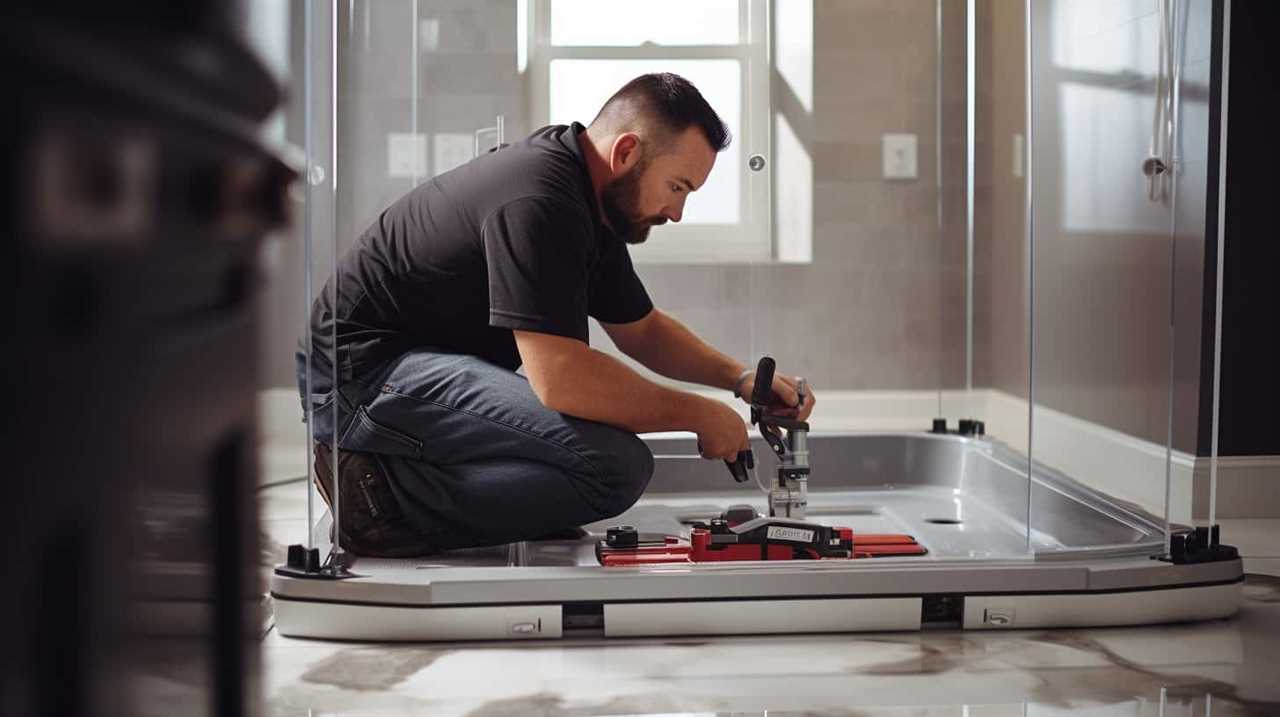
Firstly, it is crucial to keep the stall clean and tidy. This means disposing of waste properly and wiping down any surfaces that may have come into contact with bodily fluids. By doing so, we promote good hygiene and minimize the spread of germs.
Secondly, respecting gender-neutral signage is of utmost importance. These signs are designed to create an inclusive and safe environment for all individuals. It is essential to use stalls that align with your gender identity and to respect others’ privacy by not peeking or lingering unnecessarily.
By adhering to these principles of bathroom cleanliness and gender-neutral signage, we can contribute to a more comfortable and considerate restroom experience for everyone.
| Stall Etiquette |
|---|
| Keep the stall clean |
| Respect gender-neutral signage |
| Promote good hygiene |
| Ensure privacy for all |
Accessibility and Inclusivity Considerations
Considering the importance of accessibility and inclusivity, it’s crucial to regularly evaluate and improve restroom facilities to ensure that they meet the needs of all individuals. In order to achieve this, there are several key considerations that should be addressed:
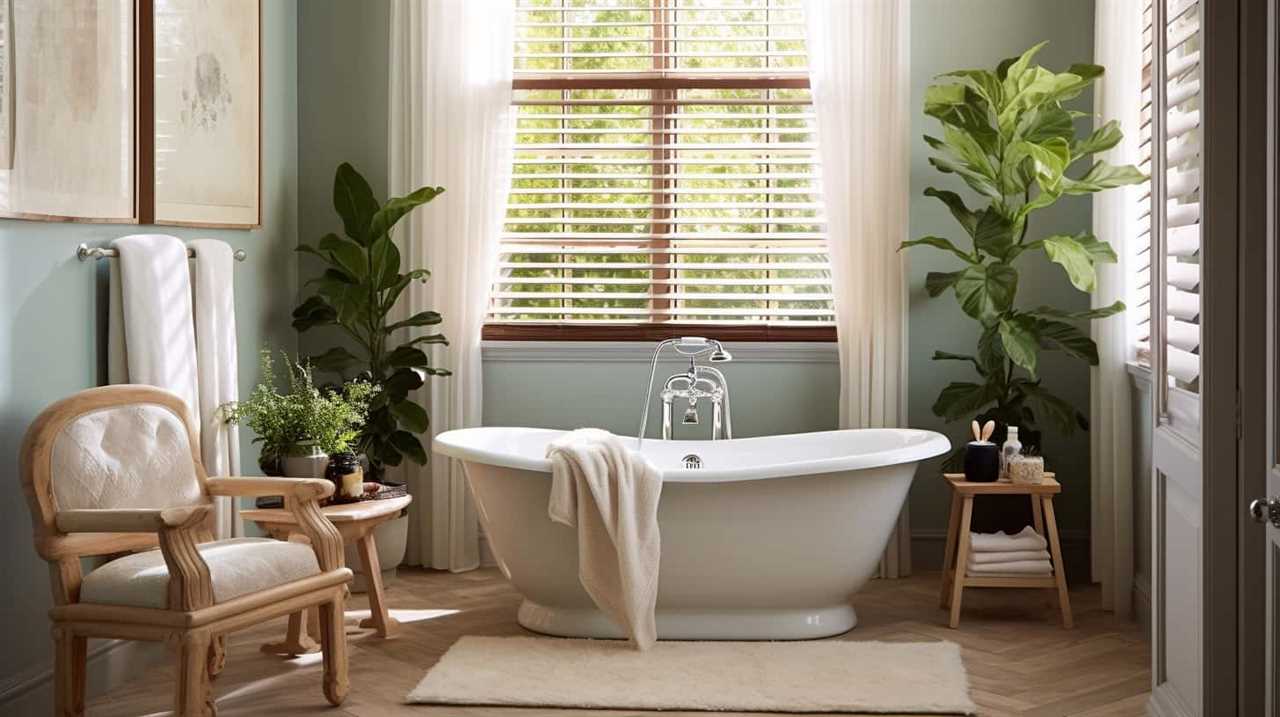
- Gender neutral signage: Implementing gender neutral signage in restroom facilities can create a more inclusive environment for individuals who identify outside of the traditional gender binary.
- Assistive technology integration: Restrooms should be equipped with assistive technology to accommodate individuals with disabilities. This may include features such as accessible stalls, grab bars, and low-height sinks.
- Clear and spacious layout: Restrooms should have a layout that allows for easy navigation and maneuverability, ensuring that individuals with mobility aids can access all areas comfortably.
- Adequate lighting and signage: Proper lighting and clear signage are essential to ensure that individuals can easily locate and navigate restroom facilities, particularly those with visual impairments.
Tips for a Comfortable Bathroom Experience
How can we ensure a comfortable bathroom experience for everyone?
There are a few key factors to consider. First, hand hygiene is crucial to maintaining a clean and healthy environment. Make sure there are well-stocked soap dispensers and functioning hand dryers or paper towel dispensers. Additionally, providing hand sanitizers can be a convenient option for those who prefer them.
Odor control is also important in creating a comfortable atmosphere. Regular cleaning and the use of air fresheners or odor-neutralizing products can help keep unpleasant smells at bay. It’s also important to ensure proper ventilation to prevent lingering odors.
Frequently Asked Questions
How Often Should Bathroom Stalls Be Cleaned and Maintained?
When it comes to bathroom stall hygiene, it is important to prioritize the frequency of cleaning and maintenance. Regularly cleaning and maintaining bathroom stalls ensures a clean and sanitary environment for all users.
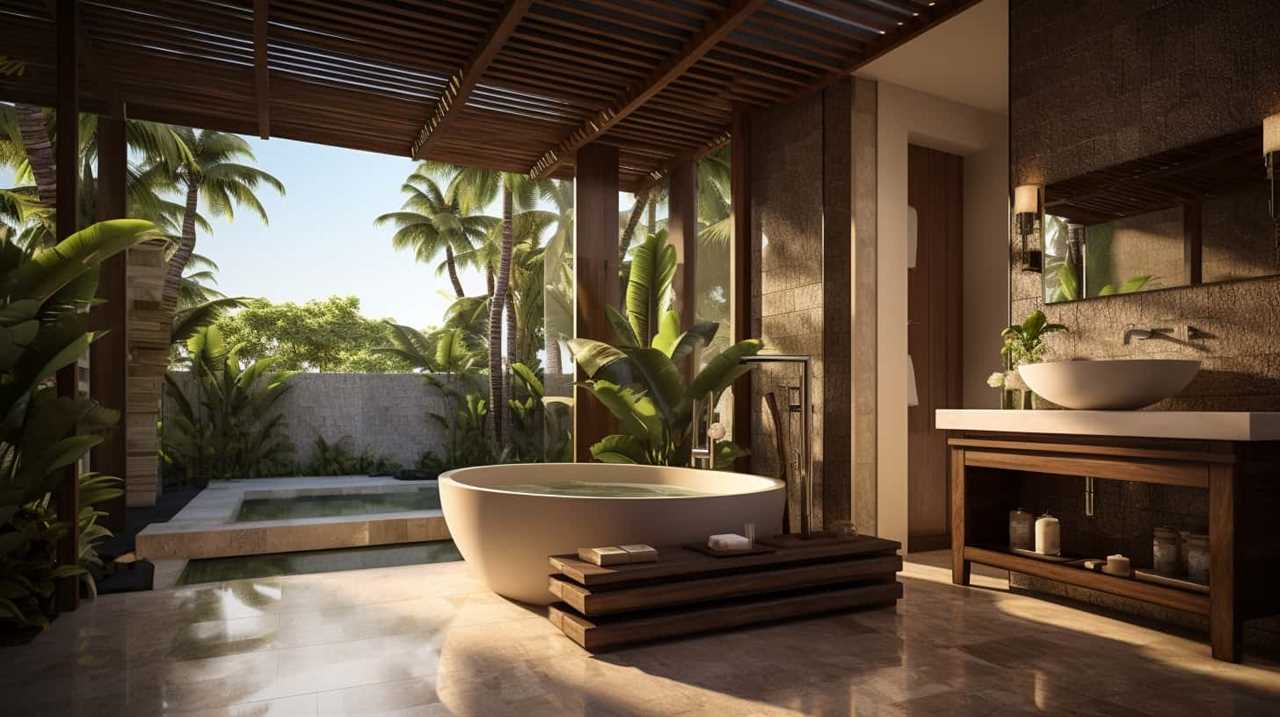
Are There Any Regulations or Guidelines for the Dimensions and Size of Bathroom Stalls?
There are regulations and guidelines in place regarding the dimensions and size of bathroom stalls. These rules ensure accessibility and comfort for all individuals. Compliance with these standards is crucial for a well-designed and inclusive restroom facility.
What Are Some Common Materials Used for Constructing Bathroom Stalls?
Toilet partitions and restroom dividers are commonly constructed using materials such as stainless steel, solid plastic, and phenolic. These materials offer durability, ease of maintenance, and resistance to moisture, making them ideal for bathroom stall construction.
Are There Any Recommended Color Schemes or Designs for Bathroom Stalls to Create a More Pleasant Atmosphere?
Color psychology and creative artwork can greatly enhance the ambiance of a bathroom stall. By carefully selecting color schemes and incorporating unique designs, we can create a more pleasant and inviting atmosphere for users.
Is There Any Technology or Innovation Being Used in Bathroom Stalls to Improve the User Experience?
Smart toilets and automated cleaning systems are examples of technology and innovation being used in bathroom stalls to improve the user experience. These advancements enhance hygiene, convenience, and overall comfort for individuals using public restrooms.

Conclusion
In conclusion, choosing the right bathroom stall may seem like a trivial decision, but it can greatly impact our comfort and privacy. From the stall design and layout to privacy features and solutions, there are various considerations to keep in mind.
Proper stall etiquette ensures a pleasant experience for everyone. Additionally, accessibility and inclusivity should be prioritized to accommodate all individuals.
So next time you enter a restroom, remember these tips for a comfortable bathroom experience. It’s not just about the stall, but the overall atmosphere that matters.
With an impeccable eye for detail and a passion for bathroom-related, Ava leads our editorial team gracefully and precisely.
Under her guidance, Best Modern Toilet has flourished as the go-to resource for modern bathroom enthusiasts. In her free time, you might find Ava exploring antique shops and looking for vintage bathroom fixtures to add to her collection.
-

 Reviews2 months ago
Reviews2 months agoBest Toilet Air Freshener: Top 10 Picks for a Fresh-Smelling Bathroom [2024]
-

 FAQ - Advanced Bathroom Queries3 months ago
FAQ - Advanced Bathroom Queries3 months agoGuide: How to Use Drano Max Gel in Your Toilet
-

 FAQ - Advanced Bathroom Queries1 month ago
FAQ - Advanced Bathroom Queries1 month agoWhich Countries Use Bidets the Most
-

 FAQ - Advanced Bathroom Queries3 months ago
FAQ - Advanced Bathroom Queries3 months agoWhy Does My Poop Leave Streaks in the Toilet
-

 Reviews2 months ago
Reviews2 months agoBest Waterless Toilets: Top Options for Eco-Friendly Bathrooms [2024]
-

 Buying Guides2 months ago
Buying Guides2 months agoWhat to Do When You Accidentally Flushed Something Down the Toilet
-

 FAQ - Advanced Bathroom Queries3 months ago
FAQ - Advanced Bathroom Queries3 months agoHow Do Toilets Work in Bali
-

 FAQ - Advanced Bathroom Queries3 months ago
FAQ - Advanced Bathroom Queries3 months agoWhat to Do if You Accidentally Flushed Something Down the Toilet





















